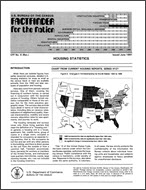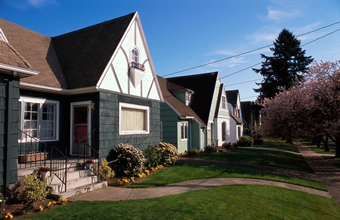Factfinder for the Nation: Housing Statistics
Factfinder for the Nation: Housing Statistics
Introduction
While there are isolated figures from earlier decennial censuses, detailed U.S. housing statistics for areas as small as the census block or tract are available primarily from the 1940 and later censuses of population and housing.
Data also come from periodic national surveys. One of them, covering the financing of nonfarm homes, is carried out in conjunction with the decennial census of housing. Others furnish statistics comparable to those of the census—but for the more populous geographic areas. The surveys also provide more detail in terms of total characteristics, including data on vacancy rates, indicators of neighborhood quality, financial characteristics, mobility and recent movers, absorbtion rates for new apartments, and journey to work.
The housing censuses and surveys cover only those living quarters that meet the definition of a "housing unit." In general, a housing unit is a house, apartment, flat, mobile home, group of rooms or a single room, occupied or intended for occupancy as separate living quarters; that is, the occupants do not live and eat with any other persons in the building, and there is direct access to the unit from the outside or from a common hall. Transient accommodations, barracks for workers or members of the Armed Forces, and institutional-type quarters (dormitories, wards, large rooming houses, etc.) are not included in the housing inventory.
Title 13 of the United States Code, the basic statute under which the Census Bureau operates, authorizes the housing census. Public compliance with the census is mandatory, under penalty of law. Response to the surveys, also taken under the same authority, is voluntary. In all cases, the law strictly protects the confidentiality of the information the Bureau collects about individual housing units and households, and subjects agency employees to heavy penalties for unauthorized disclosure.
The Census Bureau also has a construction statistics program that provides housing-related data, such as on housing starts (series C21) and completions (C22), characteristics of new one-family homes (C25), and residential alterations and repairs (C50). These are described in a separate Factfinder, CFF 9, "Construction Statistics."
Figure 1 shows the housing items in the 1990 census; these are also representative of the questions asked in prior years. About a third of the 1990 items were asked for all housing units—the 100-percent count—in order to tabulate the data by census block. The other items were asked about a fraction (sample) of the units, with the resulting data reported as estimates for larger geographic areas, such as census tracts or block-numbering areas (averaging about 4,000 people). Some statistics collected in the population part of the census may be included in the housing reports to show such data as persons per unit or per room, age and race of the householder, household composition and income, and poverty status. (For details on the population questions, see Factfinder CFF 7, "Population Statistics.")
Others in Series
Publication
Publication
Publication





